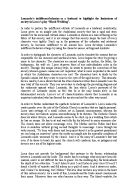Dantes Power and Limitations in "The Count of Monte Cristo". Although Edmond Dantes symbolizes God through his death and resurrection, he ironically displays many limitations as a flawed human being, which helps to explain his transformation to a humbl
Lau 3
Dantes’ Power and Limitations
Human beings with authority and power will have a natural tendency to believe that they are all powerful. Their strong reliance on their power creates a delusion of being godlike which makes their actions justifiable. However, overestimation of power will reveal their human limitations as well. In Count of Monte Cristo, the author, Alexandre Dumas explains this notion through the character of the Edmond Dantes. Although Edmond Dantes symbolizes God through his death and resurrection, he ironically displays many limitations as a flawed human being, which helps to explain his transformation to a humble man.
Edmond Dantes represents Christ through his resemblance to Christ’s descend to hell and resurrection from hell. During Dantes’ experience in Chateau d’If, Dantes described the Chateau d’If as an “abyss” (Dumas 34). The dark description of the word and its association with death implies that the Chateau d’If is a place of emptiness and suffering. To a greater extent, the author Dumas dramatically uses the archetype of fire when describing the Chateau d’If. It seems that with this archetype, the Chateau d’If is considered as a representation of spiritual hell for Dantes. In this hell, Dantes not only experiences physical death but also a spiritual death where his innocence dies away. The crucial point of his spiritual death occurs not inside the Chateau d’if but in the sea of the prison. When Dantes is thrown into the sea, he is “[dragged] to the bottom by a cannon ball [tied] to his feet” (66). The cannonball tied to Dantes represents his innocent, loving and naïve self. When Dantes cuts off the rope holding the cannonball and rises up to the sea, his old self dies away in the sea, and he resurrects into a knowledgeable and mature man. Similarly, Jesus bears down all sins of men into the cross and when he resurrects from the grave, he is transformed into a divine and pure being. Furthermore, the author Dumas uses symbolism to show similarities with Dantes and Jesus. He points out the fact that Dantes is “nineteen when he [enters] the Chateau d’If; he [is] now thirty-three” (70). The age 33 of Dantes is symbolic and representative of Jesus Christ‘s age when he rises from the dead. It seems that with this intention, Dumas wants to emphasize the fact that Dantes is indeed a Christ figure in the novel. The Chateau d’if and Christ’s hell are significant in displaying the similar situations of Christ and Dantes but most importantly, Christ and Dantes’ resurrection shows evidence that Dantes indeed embodies the qualities of Christ.







